CULTURE
Polish culture has a historical context, but it continues to evolve, incorporating old traditions with modern life. The culture of Poland developed as a result of its geography and connections to other countries, and its rich thousand-year history.
The Poland of today continues the traditions and customs of this history with origins in the Slavic culture. There were even Byzantine and Ottoman influences. Approximately 95 percent of Poland’s inhabitants are Roman Catholics, with about 75 percent attending church services regularly. This church affiliation has influenced the holidays and traditions that are such an important part of Polish culture.
- Folk Costumes
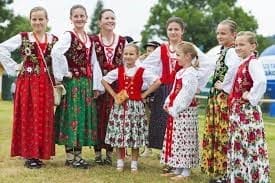
Poland’s folk costumes (stroje ludowe) are colorfully decorated and represent different regions of Poland. Men’s and women’s folk costumes are most often seen during holidays, weddings and festivals when dancers entertain audiences with traditional performances.
Regional costumes, which differ from each other, come from the historic regions of the country: Greater Poland, Lesser Poland, Mazovia, Pomerania, Warmia, Masuria, Podlasie, Kujawy, and Silesia.
You will also see differences in the mode of dress related to marital status. In Krakow, for example, a careful observer may be able to ascertain from the style of head covering not only where in the country a woman is from, but her marital status. Traditionally, unmarried women wore flower wreaths and ribbons on their heads, while married women wore white kerchiefs.
- Holidays

Since Poland’s population is overwhelmingly Roman Catholic, that means that many Polish holidays—from Easter to All Saints’ Day and Christmas—follow Catholic traditions.
If you visit Poland during holiday periods, you get the chance to see authentic Polish life and come home with a memorable cultural experience.
National and religious holidays celebrated in Poland are marked by traditions, public celebrations, or days of rest and relaxation. If you’re planning to travel to Poland, it’s a good idea to find out about traditional holidays. Some of them may be familiar like Easter and Christmas but there are many uniquely Polish holidays too like Constitution Day and their Independence Day.
While some holidays in Poland offer special opportunities for visitors to learn about Polish culture, it is also important to note that traveling during these holidays may mean that shops and public offices are closed. Plan your trip accordingly to avoid unexpected delays and cancellations.
3.All Saints’ and All Souls’ Day

On this day, Poles reunite with family members to honor the deceased and place candles and flowers at grave sites.
All Saints’ Day, observed on November 1st, is an important holiday celebrated in Poland and Lithuania, which were once one country.
All Saints’ Day is followed by All Souls’ Day (November 2nd), and it’s the evening between these two days that past generations believed that the deceased would visit the living or return to their homes.
4.Christmas Traditions
Christmas celebrations in Poland occur on both Christmas Eve and Christmas Day, but large cities in Poland take advantage of this special time of year to decorate historic centers in lights, decorations and Christmas trees. Christmas markets add to the festive atmosphere.
In Poland, Advent is the beginning of Christmas Time and may be a time of fasting, at least giving up some favorite foods. There are many special masses held. This is the time when people clean their homes and decorate for Christmas.
Christmas Eve, which is more important than Christmas Day, is known as Wigilia and is a time for a special feast enjoyed only after the first star is seen in the evening sky. Gifts are open after dinner and many people go to Midnight mass.
5.Easter Traditions
Easter in Poland is a special time of year, with religious observances and the celebration of the return of spring. City centers come alive with festivals and markets, and families uphold old customs by coloring eggs and attending church services.
Easter is one of the most important holidays in Poland. Holy Week is filled with traditions, special events, and special church services. Festivities start on Palm Sunday when palm branches get blessed
On Easter Saturday, Polish families bring baskets with bread, sausages, eggs, salt, and horseradish to church to be blessed. Each of these items has its own symbolic meaning.
On Easter Sunday after church, families enjoy a special Easter meal. Before the meal begins people take a small piece of blessed egg and exchange wishes. It is a season of renewal and hope.
- The Black Madonna: Poland’s Holiest Relic
The Black Madonna, housed in a special chapel in Jasna Gora monastery, is Poland’s most important religious icon. The Black Madonna is famous for her darkened skin and the two scars that are on her cheek. Every year, thousands of pilgrims flock to Jasna Gora to pray in the presence of this icon.
The Black Madonna icon is said to be painted on a panel that came from the table used by the Holy Family—or a copy of the original panel painted by Luke the Apostle. The dark tones of the Black Madonna’s skin are attributed to a legend that involving a fire that damaged a monastery but left the icon unscathed except for the discoloration of the pigments of the painting.
POLISH FOLK DANCES

Polish folk dances — with their colorful regional costumes and enchanting music — are both a beautiful and entertaining experience to behold. Their traditions are rooted many centuries in the past, when every region of Poland had its own dance and local style of dress. The most famous of the traditional Polish dances are:
The Kujawiak — a 19th century dance from the Kujawy region near the coast of the Baltic Sea;
The Mazurka — a dance from the Mazovian area surrounding the capital, Warsaw. An interesting fact is that the rhythm of the Mazurka dance is based on the rhythm of the work of peasants who used to tend the fields;
The Polonaise — The most elegant amongst the folk dances, the Polonaise was traditionally the dance of the Polish nobility.
When it comes to dresses, these were also unique in every part of Poland. They were normally worn with accessories such as hats, necklaces and capes. Tradition called for a married woman to wear a headscarf, while an unmarried one would wear flowers in her hair.
TRADITIONAL FOOD.
- Pierogies: Fried or Steamed Dumplings

The traditional dumpling on every Polish grandma’s menu is called a pierogi, and while other Eastern European and Slavic cultures have versions of pierogi, which trace their roots to Russia in the Middle Ages, Poles have made this dish their own.
Pierogis are made up of dough filled with cheese, potatoes, onions, cabbage, mushrooms, meat (or almost any other ingredient, savory or sweet, that you can think of). They are traditionally served while still steaming hot, either boiled or fried, and are accompanied by sour cream.
2.Bigos: Hunter’s Stew

Considered a meal in and of itself, bigos is a hearty hunter’s stew featuring a combination of cabbage, mushrooms, and various meats. Traditionally pork, bacon, or Polish sausage were used in this dish, but today bigos also may contain venison or duck instead.
The stewing process takes two to four days when prepared according to Polish traditions, allowing the flavors of each of the ingredients plenty of time to meld with one another. However, many modern restaurants often prepare their bigos overnight due to the high demand of this local and tourist favorite.
3.Makowiec: Poppy Seed Swirl Cakes

Traditionally served in Poland for the Easter holiday, these sweet rolled cakes are filled with dark fruit and nuts. Typically, ingredients in the filling include poppy seeds, walnuts, raisins, honey, and lightly-whisked egg whites. The dough for the cake is rather yeasty, making for a savory and sweet treat for the holiday season.
Poland’s textile traditions: a thread through time
In the spinners’ room the damsels sit like angels
Singing and spinning their threads:
“Spin yourself spindle,
Spin yourself thread
Spin yourself silk
Wind yourself long
Wind yourself longer
Longer and longer to remember…”
Beautifully performed famous Moniuszko’s nursery rhymes
Polish children have sung this old rhyme since the 1800s as the art of creating textiles has long been an integral part of Polish culture. Through centuries of change, the textiles produced have provided a sense of comfort, security and identity and have been interwoven in every aspect of Polish life.
Despite often harsh and changing political landscapes, Polish artisans have been able to maintain and adapt the handmade textile traditions of the past so that today, they remain a significant aspect of Polish culture.
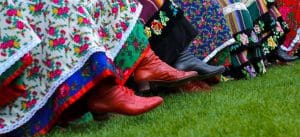
Traditional skirts: designs, patterns, colors and trims
In Warsaw, crafted willow basketry industries have flourished across the generations. Changing with the seasons, the muted shades of the 75 varieties of wicker have been used to create beautiful and sturdy vessels and installations, and are woven into the fabric of ceremonial and daily life.

Willow woven baskets used for fresh food and produce
The Wawel Castle in Krakow is famous for the tapestries of Sigismund Augustus Jagiellon, which date back to the 16th century. Woven in Brussels, these tapestries amazingly survived centuries of wars, displacement and stormy journeys and remain a Polish national treasure. This unique collection consists of 138 large arrases, 136 being kept at Wawel, together with other unique examples of fine tapestries, textiles, garments and embossed leather wall decorations. Also Wawel Castle is a home of the Art of the Orient collection, which demonstrates examples of Far East decorative arts in the culture of the old Polish Commonwealth.
Zakopane is the regional centre of the traditional Tatra Mountains people, whose unique folk art developed through history as a response to the merging of the East and West. From carved and inlaid timber, painted beads and glass, felted wool garments heavily embroidered with traditional motifs and decorated with embossed leather to metal jewellery and accessories, these handcrafted pieces reflect the beauty and history of one of Poland’s traditional cultures.
Wycinanki Embroidery: Polish Folk Art for the Ages
Folk art is a longtime favorite among textile artisans. Wycinanki, Polish folk art popular as paper cuttings, has been reproduced into beautiful machine embroidery. Even centuries later, its bright colors and whimsical depictions make the designs popular as ever.

Photos via Embroidery Library
Folk art has become some of the most loved artwork. Once considered the creation of peasantry, the art form of common people has become much beloved and highly coveted.

Photos via Embroidery Library
What is Wycinanki embroidery?
Wycinanki, pronounced vee-chee-non-kee, is Polish folk art originally exhibited in paper cuttings.

Photos via Golden Needle Designs
Popular in the mid-1800s, subjects often included flowers, birds, medallions and holiday motifs. Designs were highly intricate and considered some of the most beautiful paper cutouts in the world.
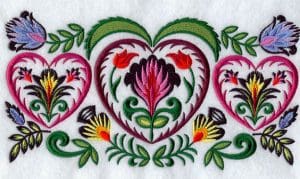 Photo via Embroidery Library
Photo via Embroidery Library
Wycinanki was created during relaxation after the day’s work was done, much like reading or hand stitching in later years. Patterns are thought to have originated from sheep skin window coverings. Countryside cottages used sheep shears to cut the decorative decorative patterns as a way to let in air and light.

Kurpie patterns are a single color while those from Lowicz territory include several layered colors. Both lend themselves beautifully to embroidery.
TRADITIONAL COSTUMES
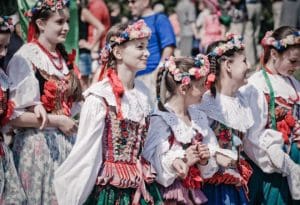
Overview of traditional Polish costumes.
The beauty of traditional Polish costumes is the same as elsewhere in the world. In the past, traditional clothing was one of the main elements of Polish rural culture recorded in festival and ritual models. These dresses are considered polite and noble and are only worn for special occasions such as religious celebrations, seasonal festivals, and essential events in life such as weddings. They are a cultural expression of origin at a small regional level.

People can recognize the difference based on small details on clothing such as embroidery pattern or color and width of striped fabric. Based on this difference. They can realize which region in which village. Different areas will have different textures, and these details are passed on from generation to generation.
Ethnic costumes of Poland vary by region. They are not worn in everyday life but at folk festivals, folk weddings, religious holidays, harvest festivals, and other special occasions. Costumes can reflect the region and sometimes social or marital status.
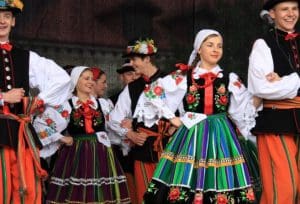
History of traditional Polish costumes.
Traditional fashion and costumes in Poland are influenced by natural resources, climate and cultures. There are about 60 unique costumes attributed to different regions in Poland, thanks to these varied influences, each area of Poland has its local traditional costumes.
Traditional costumes in Poland began to become popular in the second half of the nineteenth century when fabrics were very cheap and massively produced. At the same time, Polish farmers were no longer in the peasant class, and their political-economic position improved significantly, so they could afford to trade more, and They want to show their pride through costumes.

When did the Poles wear traditional clothes?
In the past, traditional costumes were very noble and polite. So the Polish people wear only during festivals, holidays or special occasions like weddings, etc.
Today, Polish people today still wear traditional clothes on special occasions. While some special areas, folk costumes are trendy and more prevalent than in other regions. They often wear traditional costumes when going to church, in palanquin processions, village festivals, and weddings. For men living in the Tatra mountain area, they can wear local folk like their casual attire, especially when this place is in the time of investment and attracting tourists.

Distinguish traditional costumes of men and women
Women’s traditional costume.
A complete traditional costume of Polish women including embroidery vest, white shirt, and long skirt. This style is seen in many variations of traditional costumes, with embroidery on the shirt, details of dresses and aprons and skirt length providing clues about its origins.
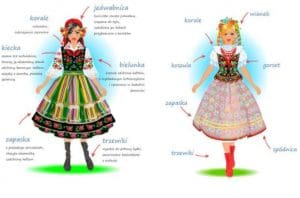
More specifically, if you look closely at the headgear of a woman, you can tell whether the person is married or not.
Women’s folk costume from Poland: This folk costume’s hat is lined with braids and decorated with embroidery. The back of the shirt is also embroidered, which is traditional in folk costumes from the Krakow region of Poland. Traditionally, unmarried women wear flowers and garlands on their heads, while married women wear white scarves. This woman wore a long traditional braid and combined with the bandages on her hat, showed that she was not married.

Men’s traditional costume.
A complete traditional costume of Polish men includes a long coat with high leather boots and a flower-covered cap. High heels in this style are designed for dancing.
The most famous outfit in Poland is the Bronowice of Krakow; people from all over the country can recognize this outfit. There are also quite a few other favorite outfits such as costumes from Łowicz, near Warsaw city and the costumes of Tatry mountain people – especially Podhale.
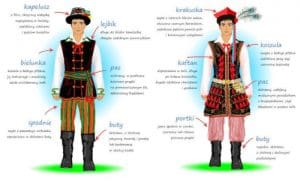
When traveling through the central areas between Kraków and Warsaw, Kielce, Opoczno, St. Cross (Swietokrzyski area), visitors can see women wearing zapaski – a full shawl over their shoulders. Zapaska is decorated with stripes of different colors and designs

TOURISM
In Poland, we have everything: beautiful coastal beaches and sand dunes, glacier-carved lake districts, lowlands as flat as a pancake, splendid forests, old and new mountains (including the only table-like mountains in Europe!), even a desert. Just you try to say that Poland does not live in wealth!

Offical Tourism Website:
Article curated by : Bhavika Gulrajani
image courtesy : google.

